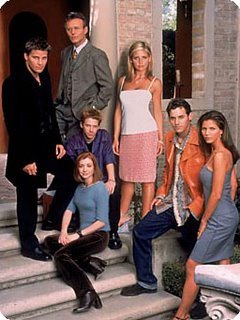Getting Buffed

I'm using an upcoming unit in our SciFi/Fantasy class on Buffy the Vampire Slayer as an excuse to read up on Buffy criticism. Here's a sampling of what I've read so far:
Seven Seasons of Buffy: Science Fiction and Fantasy Writers Discuss Their Favorite Television Show
This was a great introduction to Buffy criticism. A collection of essays written by scifi/fan authors who are Buffy fans, it includes some fun essays (Is That Your Final Answer...? by Roxanne Longstreet Conrad) as well as some readable discussions of important issues (Where's the Religion in Willow's Wicca?). This one assumes familiarity with all seven seasons of the show.
Buffy the Vampire Slayer: A Critical Reading of the Series by Anne Billson
A general critical look at the show overall, this work includes brief summaries of each season at the beginnings of each chapter. The first chapter is a great look at the history of female heroes in TV (or lack thereof) and Buffy's role as a trailblazer for strong female characters. Chapter Two gives some great background info on the show (how it came to be), and the remaining chapters look at issues like "Love and Other Catastrophes" and "Revenge of the Nerds." Again, probably best to be familiar with all seven seasons, although the summaries will help if your memory needs to be jogged.
What Would Buffy Do? The Vampire Slayer as Spiritual Guide by Jana Riess
Although it sounds as if it could be a bit preachy, this was a completely readable look at all the spiritual aspects of Buffy - and when I say all, I mean it wasn't just from a Christian perspective. I loved the comparison of Buffy to a lama (she is a chosen one who inherits the wisdom of all those who have come before her) as well as the exploration of the themes of sef-sacrifice, friendship, self-reliance, spiritual mentors & humor's role in spirituality. This is not a stuffy tome that will be a turn-off to non-religious fans, but a great exploration of several of the weightier themes addressed in the show.
Appendixes contain summaries of each season as well as character profiles, but to really appreciate the book, you should watch the shows themselves. There are also a few spoilers for the Buffy spin-off Angel in this one, especially in the chapter on redemption, which examines Angel's character closely.
What I'm Reading: More Buffy books!
On My Book Shelf: Buffy, and Finding Serenity, a collection of critical essays on Joss Whedon's series Firefly


